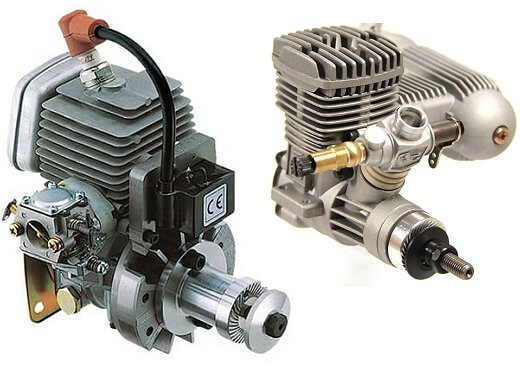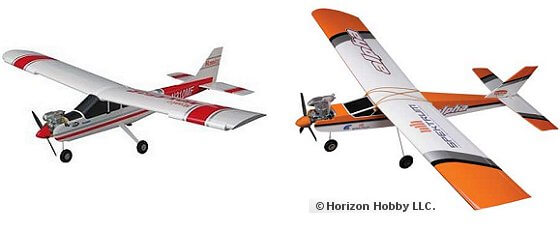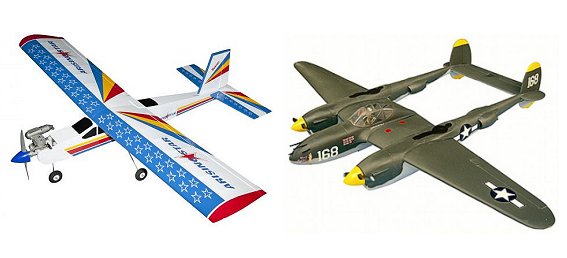'Gas' Powered RC Airplanes
The Choice for Engine Lovers!
Before we get in to this article, I should define what I mean by 'gas rc airplanes'.
The term gas is often a generic one used to cover all types of IC (internal combustion) power, but this page mainly refers to the most popular kind - glow plug or 'nitro' powered planes.
If you're in North America, the word gas commonly refers to gasoline (petrol), so my apologies in advance for any confusion. The fact of the matter is that gasoline and glow plug/nitro rc planes have all been given the 'gas' label over the years.
With that said, IC airplane characteristics are all very similar, regardless of the exact fuel type and where you are in the world!
Glow Plug vs. Nitro - What's In a Name?
Glow, glow plug and nitro are just different names for exactly the same power type.
The name 'nitro' actually comes from nitromethane, a glow fuel ingredient. The name was really adopted for radio control planes (and helis) from the rc car and boat world, where it had been used to make the vehicles sound more macho and racy!
A false, but very marketable, association could be made between nitromethane and nitrous-oxide, used in race cars to improve performance. The latter is commonly shortened to nitrous but can also be called nitro, which certainly did the trick for the rc manufacturers!
Glow / glow plug comes from the fact that these engines use a, erm, glow plug to ignite the fuel/air mixture in the combustion chamber, rather than a spark plug.
Before electric power (EP) became mainstream, in the early 2000s, glow powered planes made up the majority of planes found at your average club field. Glow plug powered rc airplanes are more restricted to club sites simply because they aren't as suitable for flying in public places (eg parks) as EP planes are, due to noise issues.
Gas (petrol) vs. Glow Plug

Above: a petrol (left) and glow plug rc plane engine.
True petrol (gasoline) power isn't quite as popular as glow, but in recent times rc engine manufacturers have been producing more, and user-friendlier, petrol engines and they are now becoming very popular.
One advantage of petrol over glow is that of fuel cost, with petrol being so much cheaper. A petrol engine also burns cleaner, whereas glow fuel can leave a very oily residue. A disadvantage with petrol is that of smell - we all know how strong it is, and your rc airplane storage hanger (and car) can become very smelly with the slightest spillage.
Petrol engines are more complex to operate, since they require an electronically operated ignition system. This also makes them a bit more costly to buy, size-for-size.
RTF Gas RC Trainers
For the beginner, buying and flying an IC powered rc plane is easier than it ever has been in the past, thanks to the modern day RTF (Ready To Fly) glow plug trainers available.
Two of the first mass-produced RTFs to appear were the Alpha Trainer and the NexStar Select 46, both shown below:

Both these beginner rc planes, although no longer manufactured, proved to be very popular glow trainers, for beginners either looking to step up from an electric rc airplane or to fly IC from scratch.
Sold fully RTF, no construction work is needed on such airplanes, just some basic final assembly. Learn more about RTF rc planes.
RC planes like these are letting more and more people take to the skies with a proper multi-channel glow plug powered model, and this kind of plane is perfect as an introduction to IC radio control flying, either from scratch or as a natural progression from electric rc flying.
RTF doesn't always mean RTF!
Ready To Fly IC planes can be assembled in very little time, and that's a great incentive for anyone looking to start flying gas rc airplanes with the minimum amount of fuss.
That said, instruction manuals do need to be read, understood and followed thoroughly and the completed airplane should always be checked over by a competent modeler prior to flight. The term RTF means that the plane has already been built and has everything it needs to fly - it doesn't necessarily mean that it's going to fly out the box without some adjustments having to be made!
If you intend joining a local rc plane club and getting one-to-one instruction, your instructor will check the plane over before he flies it. If you can't or don't want to join a club and are relying on an experienced rc pilot friend to teach you, it should be his/her job to check the plane over before its maiden flight.
Pay close attention to all the checks and get him/her to explain anything you're not clear about.
If you can't get any club/friend help then consider joining an internet forum for help, or taking it to a local hobby shop for a check over. Whatever you do you must be happy that your airplane is 100% safe for flight before it gets airborne, or bad things can - and will - happen!
Scale vs. Non-Scale Gas RC Planes

Above: from trainers to twins, gas RC planes can be non-scale or scale.
The trainer planes shown at the start of this article are non-scale in that they are fictitious designs, but maybe you like the idea of flying scale rc airplanes? A scale model is one that has been modelled from a real-life subject.
The choice of scale RTF gas powered airplanes isn't as large as non-scale, but they are available. Of course, Ready To Fly isn't your only option; assembling an Almost Ready To Fly (ARF) plane or building from a kit / plan greatly extends the range of scale gas rc planes available.
In recent years the range of scale ARFs has increased dramatically, and the quality improved greatly.
Building a radio controlled plane from a kit/plan is a very involved process, but ARF planes are an excellent compromise if you want a gentle introduction to model building techniques. An Almost Ready To Fly plane comes 90% completed, leaving you to buy and install the engine and radio gear and do some final assembly work.
There are plenty of non-scale gas powered ARF planes available too, so you should be able to find something depending on your desire!
Popular scale subjects for rc pilots include P-51 Mustangs, Spitfires and other warbirds, Piper Cubs, Cessnas and vintage planes to name but a few. The actual list is seemingly endless, in fact I doubt there's a full size plane in the world that hasn't been reproduced in radio control form at one time or another!
An interesting point is that gas rc airplanes are very widely available, unlike gas rc helicopters that seemed to die a quick death when mainstream electric rc power came along.
Points to Remember When Choosing a Gas RC Plane
Typical rc trainer airplanes ('trainers') generally follow a basic pattern; they are of a high wing design with noticeable dihedral, which is the upward angle of each wing panel when viewed from the front/rear of the plane.
Gas powered trainer planes typically vary around the '40' or '46' size. That's to say they have been designed to take a 40 or 46 (.40/.46 cu.in) 2-stroke glow plug engine, and generally speaking they have a wingspan of around 60 inches/152cm. The two trainers shown at the start of this page are typical examples.
This style of high-wing trainer is the most stable in the air, which is exactly what you need when learning to fly radio control airplanes. So it's best to start with this design airplane and work your way up to faster, more aerobatic (low wing) planes as you gain experience.
A few other points to bear in mind when thinking about buying a gas rc airplane are:
- Flying gas rc planes might restrict you to flying at a model flying club if you don't know anyone with, or have access to, any private land (access with permission, of course!). Use the rc plane club directory to try and find a club in your area. Electric rc planes are much better suited to places like public parks, because they are quieter and less intrusive.
- Gas rc planes do require certain items of field equipment because of the engine. Learn more about rc airplane accessories.
- Gas planes are more involved than electric ones. The engine means a higher level of maintenance is required, and you need to take fuel-proofing in to account.
- You'll have on-going fuel costs with a gas plane.
But with all that said, bear these responses to those points in mind:
- 1. Joining an rc flying club is a good thing to do and an excellent way to become quickly involved in the hobby. You'll make new friends, learn heaps and be able to share your enthusiasm with lots of folks who will actually understand your new found passion!
- 2. Although some accessories are essential, many of them can be lent to you by fellow modellers who you fly with, this is especially true if you do join a club. So in your early days you can get away without buying everything in one hit.
- 3. Higher levels of maintenance and involvement is never a bad thing. You'll learn more about your plane and how it works, and as a result you'll get more out of your new hobby.
- 4. There's no real defence to the on-going fuel costs! Over a year you will likely spend more on fuel than you will on buying a few battery packs for an electric plane. All I can say here is that a petrol plane will cost you less than a glow plug one to fill up.
Gas rc airplanes will bring you lots of fun and excitement but do be aware that they are a few steps up from simple electric powered rc airplanes, both in terms of learning and cost.
So if you're a true motor-head and need the noise and smell of internal combustion power to keep you happy, why not try and contact your local club, pop along to their flying field and chat to some pilots to see how it's done.
